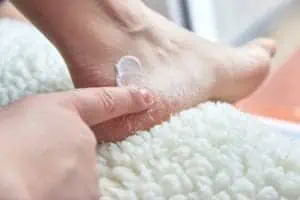
Why does it seem like no matter how much moisturizer you slather on your feet, they still look and feel as if you’ve been living in a desert? The skin on the feet has fewer oil glands to keep them hydrated, so it’s no wonder that trying to keep them soft and smooth can be rough going. That goes double if you suffer from hard, dry, cracked heels.
Dry, cold weather, standing for long periods, walking a lot, wearing shoes that are too tight and using harsh soaps can contribute to dry, cracked feet and heels. But so can skin conditions such as athlete’s foot, eczema and psoriasis. Diabetes can also cause changes in the feet that lead to dry, cracked foot skin.
For many people, the following six home remedies can help turn the skin on the feet from rough, dry and uncomfortable to smooth, hydrated and soft.
1. A pumice stone or foot scrub
Exfoliation gets rid of dry, dead skin, revealing the softer, smoother skin underneath. You can exfoliate using a pumice stone or an over-the-counter foot scrub, preferably after a shower, bath or foot soak in warm water (add a little Epsom salt for good measure), when the skin is soft. If you use a pumice stone, don’t be overly aggressive. Apply a moisturizing cream when you’re done.
Do not exfoliate your feet if you have sores or open wounds.
2. A foot file or rasp
A foot file is a tool with a handle and an abrasive metal surface that mechanically exfoliates the skin. Some foot files look like cheese graters. These may be too rough on the feet and in most cases should only be used on calloused heels, if at all.
Like pumice stones, foot files are best used after a bath, shower, or foot soak, when the skin has been softened. An electronic foot file with a head that spins is another option, especially for removing hard, dead skin from the heels. These are typically used on your feet when they are dry, but some waterproof models can be used in the shower.
3. Foot cream or heel balm
For seriously dry feet, skip the lotion. Lotions contain a lot of water and aren’t as moisturizing as creams and ointments. Consider buying a cream or balm designed specifically for feet or heels. These are typically thicker and may contain softening and exfoliating ingredients such as alpha hydroxy acid, salicylic acid, hyaluronic acid, lactic acid or urea. Regular use helps prevent cracked heels.
At night, apply a heavy moisturizing cream, a foot cream or a thin layer of petroleum jelly to your feet and wear cotton socks to lock in the moisture and keep your sheets clean.
4. Moisturizing gel socks or heel socks
Available online, moisturizing foot socks or heel socks, also called heel sleeves, can give you the effects of moisturizer-plus-cotton-socks without the mess. They’re designed with a hydrating gel lining. Wear them for a few hours a day or while you sleep.
5. Foot peel masks
Foot peel masks are the latest internet sensation. These bootie-shaped sheet masks are worn for an hour, then discarded. In a week or more, dead skin will begin peeling off in large patches, revealing baby-soft skin beneath.
6. Liquid bandage
If you have deep cracks in your heels, consider applying a liquid bandage, which is not a bandage at all, but a spray. These products form a seal over cracks, making walking less painful and closing the entryway for dirt and bacteria.
If these home treatments for dry, cracked skin on your feet aren’t working, see a dermatologist or podiatrist. The provider can examine your feet, determine whether any health conditions may be playing a role and develop an effective treatment plan.
ADVISORY: If you have diabetes, avoid home remedies until speaking with your doctor about the dry skin on your feet. If you suspect you may have athlete’s foot, see a dermatologist or your primary care physician. In addition to dryness on the bottoms or sides of your feet and cracking of the skin, symptoms of athlete’s foot include itching, burning, stinging, and flaking between the toes.
Article Written By: Jessica Brown is a health and science writer/editor based in Brooklyn, New York. Her work has appeared in Prevention, Johnson & Johnson, the Breast Cancer Research Foundation, and many more.





